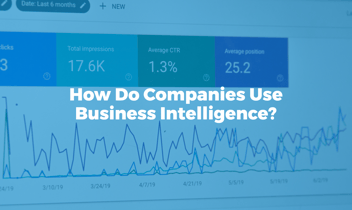We explore the role of business intelligence and BI tools in the transformation of data into insights and the consolidation of self-service BI.
Delving into the intricacies of data exploration, visualization, and analysis, we delve into the multifaceted ways BI tools streamline the path from data to insights. Join us as we examine real-world examples, industry best practices, and the transformative power of self-service BI. In a world where agility and informed decision-making are paramount, discover how businesses are leveraging BI tools to foster a data-centric culture that propels innovation and success.

In today's data-driven business landscape, the ability to extract meaningful insights from the vast sea of information is a competitive differentiator. Data, once a raw asset, has evolved into a strategic resource that holds the key to informed decision-making and organizational growth. To harness its full potential, businesses must master the art of converting data into actionable insight, a journey where Business Intelligence (BI) tools emerge as indispensable allies.
Modern business intelligence tools play a major role in the consolidation of a self-service BI model within an organization. Beyond technology, self-service BI signifies a paradigm shift, empowering professionals across the organization to engage with data autonomously, analyze patterns, and uncover trends. By providing a deep understanding of data nuances, BI tools enable stakeholders to make informed decisions with precision and confidence.
If you are interested in developing a self-service BI model in your company, don't miss our e-book "10 Best Practices for Enterprise Adoption of a Self-Service BI Model". Download it now!
What is business intelligence?
Business Intelligence, or BI, is a sophisticated framework that empowers executives to harness the true potential of data. It's not just about raw numbers; it's about deriving meaning from them. Business intelligence enables companies to see the bigger picture, detect trends, and uncover hidden patterns that might otherwise go unnoticed. These insights provide executives with a comprehensive understanding of their business's current state, its past performance, and even future possibilities.
Data analytics is one of the most recognizable parts of BI. However, business intelligence goes beyond data analysis and involves other disciplines such as data visualization. In order to transform data into business insights that drive action, information must be presented in a visually compelling manner through interactive dashboards, reports, and charts with the help of BI tools such as Power BI.
Data visualization empowers business executives when making their decisions, data-driven decisions, since they don’t need to sift through pages of spreadsheets; but otherwise have a concise, dynamic overview that paints a complete picture of their business activity.
Why should a company invest in business intelligence?
Investing in business intelligence is an investment in a company's ability to adapt, innovate, and thrive in an increasingly competitive world. It's an investment in ensuring that business decisions are not only well-informed but also agile, allowing organizations to stay ahead of the curve. By utilizing the power of BI, a company is setting the stage for data-driven growth and success.
With business intelligence, companies have the ability to swiftly respond to market changes, capitalize on emerging opportunities, and address potential risks before they escalate, among many other use cases.
The most significant use case of BI are data-driven decisions. The data-driven decision-making process reduces uncertainty, enhances efficiency, and ultimately impacts the bottom line positively. Instead of relying solely on gut feelings, organizations base their strategies on concrete evidence.
In short, BI is key to unlock the potential within data, transforming it into actionable insights that fuel confident decision-making. It's an investment that not only yields measurable results but also empowers organizations to navigate the future with precision and confidence.
Business intelligence: Transforming data into insights

Business intelligence follows many steps to transform raw data and information into easily summarized insights for use by all users in the organization. As it is impossible to explain each one of the steps involved in data processing, below we list the most important 4 steps of a business intelligence process.
The first three (data collection, analysis and visualization) define the stage for the final step of decision making. Before using BI, companies had to perform much of the analysis manually, but BI tools automate many of the processes and save companies time and effort.
The 4 steps of BI to transform data into insights
Step 1: Gathering and Refining Data from Diverse Sources
Modern business intelligence tools employ extract, transform, and load (ETL) processes to consolidate both structured and unstructured data from a variety of sources. Following extraction, this data undergoes a transformation phase, where it is reshaped to fit a standardized format. The final refined data is then stored centrally, enabling applications to seamlessly analyze and query it as a comprehensive dataset.
Step 2: Unveiling Patterns and Discrepancies
The process of data mining, sometimes referred to as data discovery, leverages automation to swiftly analyze data sets, unveiling patterns and anomalies that shed light on the present state of affairs within the business. Business intelligence tools incorporate diverse forms of data modeling and analytics —exploratory, descriptive, statistical, and predictive— that delve into data, predict trends and offer suggestions.
Step 3: Presenting Insights Through Data Visualization
Business intelligence reports leverage data visualization techniques to simplify comprehension and facilitate the dissemination of findings. These reports utilize a range of strategies, including interactive maps, charts, graphs, and data dashboards, to provide users with a real-time snapshot of the enterprise's current state.
Step 4: Prompt Action Based on Real-Time Insights
Translating historical and current data into actionable insights empowers companies to swiftly transition from comprehension to implementation. Business intelligence fosters on-the-fly adjustments and strategic shifts that eliminate inefficiencies, accommodate shifts in the market, rectify supply chain hitches, and address customer concerns effectively.
How do BI tools empower businesses in the adoption of a self-service BI model?
Business intelligence tools play a pivotal role in enabling businesses to embrace and successfully implement a self-service BI model. Self-service business intelligence is all about empowering users across various departments to access, analyze, and interpret data on their own, without relying heavily on IT or data specialists.
Here's how business intelligence tools empower the adoption of a self-service BI model:
-
User-Friendly Interfaces: BI tools offer intuitive and user-friendly interfaces that don't require extensive technical skills. This makes it easy for business users, including non-technical executives, to interact with data, create reports, and build visualizations without needing advanced IT knowledge.
-
Data Accessibility: BI tools connect to diverse data sources, including databases, spreadsheets, and cloud services. This allows users to access the data they need directly, without waiting for data analysts to provide them with specific reports.
-
Data Preparation and Cleansing: BI tools often incorporate data preparation and cleaning features. Business users can transform and cleanse data themselves, ensuring accuracy and consistency before analysis.
-
Ad Hoc Reporting: Self-service BI tools enable users to create ad hoc reports and dashboards tailored to their specific needs. This agility empowers executives to answer questions in real-time and explore data from different angles as new inquiries arise.
-
Data Visualization: These tools offer a wide range of visualization options, including charts, graphs, and interactive dashboards. Visualizations make complex data more comprehensible, facilitating better understanding and decision-making.
-
Drill-Down Capabilities: BI tools allow users to drill down from summarized data into more granular details. This enables executives to explore data at varying levels of granularity, uncovering insights that might not be apparent in high-level summaries.
-
Predictive Analytics: Some advanced BI tools incorporate predictive analytics capabilities. This empowers executives to forecast future trends and outcomes based on historical data patterns, aiding in strategic planning.
-
Collaboration: Many BI tools enable collaboration by allowing users to share reports and dashboards with colleagues, fostering a culture of data-driven decision-making across the organization.
-
Reduced IT Dependency: By offering a self-service approach, BI tools reduce the burden on IT departments. Business users can perform data analysis and reporting tasks independently, freeing up IT resources for more complex tasks.
-
Quick Insights: Self-service BI accelerates the time it takes to gain insights. Executives don't have to wait for custom reports; they can explore and visualize data on the fly, leading to faster decision-making.
-
Empowerment and Ownership: Implementing self-service BI fosters a sense of ownership and empowerment among business users. Executives can make data-driven decisions with confidence, knowing they are directly involved in the analysis process.
In conclusion, business intelligence tools play a crucial role in transforming raw data into actionable insights, empowering organizations to make informed decisions and drive innovation.
By adopting a self-service BI model, businesses can enable professionals at all levels to engage with data autonomously, analyze patterns, and uncover trends. These tools provide user-friendly interfaces, data accessibility, and a range of analytical capabilities, reducing IT dependency and accelerating the time it takes to gain insights. Investing in business intelligence is an investment in the future success of a company, as it allows for agility, informed decision-making, and data-driven growth.
To learn more about best practices for implementing a self-service BI model, be sure to download our e-book "10 Best Practices for Enterprise Adoption of a Self-Service BI Model."



